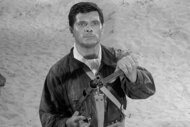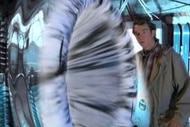Create a free profile to get unlimited access to exclusive videos, sweepstakes, and more!
How Doctor Who and Timeless showcase forgotten women of history

William Shakespeare, Winston Churchill, Abraham Lincoln, and John F. Kennedy are some of the influential historical figures that have appeared as characters in Doctor Who and Timeless. Traveling through time in an attempt to protect history (and save humanity) often leads to rubbing shoulders with a person of note.
By throwing in a familiar face, it ensures the immediate stakes are raised but also offers a knowing wink to the audience. The recognizable places and faces provide an instant connection to events and characters that have been emphasized for their importance; however, it is the portrayal of lesser-known achievements that can lead to a more rewarding viewing experience.
In depicting figures who aren't household names, entertainment doubles as a prompt to find out more after the credits roll. Looking beyond the obvious royal, political, and celebrity figures offers up richer storytelling possibilities. It also imparts a deeper understanding of the men and women who played a vital role in modern living as we know it. No longer will they be a footnote or an addendum to a conversation.
Knowledge levels vary when it comes to the variety of the people that have appeared in Doctor Who and Timeless storylines, although it is safe to say the majority of adult viewers will be aware of presidents who were assassinated and Rosa Parks' impact. However, it is also important to remember that Doctor Who is a family show, so there are plenty of teachable moments to be had for audience members of all ages. Figures across the spectrum should be celebrated, from those who appear on banknotes to the ones without that same level of name recognition.
Historical female STEM heroes took center stage in Doctor Who's Season 12 episode, “Spyfall, Part 2,” which saw these women targetted for the role they played in the development of computer technology. Ada Lovelace has been immortalized in fiction before, including relatively recent episodes of The Frankenstein Chronicles and Victoria; she has also appeared in several steampunk stories across the year, whereas Noor Inayat Khan's achievements have been celebrated in non-fiction documentaries such as Netflix's Churchills Secret Agents: The New Recruits. In 2017, Lovelace was the subject of a Google Doodle, but it is unlikely that either woman is as famous as some of their STEM male counterparts. Thanks to Doctor Who, more people now know a fraction of their accomplishments and bravery when all odds were stacked against them.
Certain TV shows lead to a trip to Wikipedia after (or sometimes during) an episode to find more information about the events you've just watched. A straight historical depiction like The Crown is an obvious example, but Doctor Who and Timeless have led to many online deep dives that have often spilled into further reading and research. Truly, it can read as far more organic for the Doctor to encounter someone such as Ada Lovelace than Queen Elizabeth I.
The Thirteenth Doctor finds herself without her TARDIS in 1834, but who needs a time machine when she has an Ada (Sylvie Briggs) to help? Taking place in the year before Ada was married (she introduces herself as Ada Gordon), her work with Charles Babbage is at the heart of this particular story. Babbage is known as the “father of the computer,” although Lovelace is credited with publishing the first algorithm — making her one of the original computer programmers — in their work together on the Analytical Engine. Babbage even once referred to her as the "Enchantress of Numbers."
Ada is the ideal figure for Doctor Who to feature, as she successfully became more than just an ornament in her home. She was a woman of means and privilege, the daughter of the poet Lord Byron who married a nobleman and scientist, but she still had many obstacles to surmount to make her mark, even if it has taken longer for her achievements to get the same level of attention as her male counterparts. Rather than Babbage, however, the Doctor needs Ada to help her against the Master in 1834. She also forces her way into the future by grabbing hold of the Doctor’s hand, which leads to the formation of a formidable STEM squad.
In Paris 1943, the dream team expands to include Noor Inayat Khan (Aurora Marion), which introduces some audience members (myself included) to a British WWII hero. Courage in isolation while living in an increasingly dangerous situation is something Noor possessed, which is touched upon in “Spyfall Part 2.”
“Ada and Noor are extraordinary women and there is a lot more to their stories that we can tell in a Doctor Who story,” explained showrunner Chris Chibnall. Khan is particularly significant in her covert work; she was the first female wireless operator to be sent behind enemy lines in WWII, and she was also Britain’s first Muslim war heroine.
Both Lovelace and Khan are significant, not only for their contribution to STEM but also for the challenges and obstacles they faced as well as the sacrifices they made — Khan was killed in action before the war was over. It shouldn’t take an episode of Doctor Who for audiences to become familiar with their achievements. Both women should be taught in schools or have an award-winning miniseries or biopic about them.
Nevertheless, while I find it shameful that I knew very little of both women before this episode, I am grateful their stories are now being told on such a big platform. Television is great for entertainment purposes, but post-episode historical deep dives are just as rewarding.
Timeless sadly didn’t have the longevity of the Doctor, but in the short time it was on the air, many historical figures were honored. Women in STEM also featured, with actress Hedy Lamarr's vital contribution to Wi-Fi as we know it today showcased in the Season 2 episode "Hollywoodland." Over the last few years, Lamarr's invention has been the focus of documentaries and inspiration for characters such as Agent Carter's actress-scientist Whitney Frost. Gal Gadot is set to play the multi-hyphen star in the as-yet-untitled Hedy Lamarr Showtime miniseries, which will likely shed further light on her incredible invention. Nevertheless, it is only really in the last decade that Lamarr's frequency-hopping innovation has featured this heavily in various adaptations.
The Doctor's historical knowledge is unrivaled, but Timeless' Lucy Preston (Abigail Spencer) has a pretty good handle on influential figures across the centuries; she is a history professor, after all. This is her area of expertise, which comes in handy with figures like Grace Humiston, aka Mrs. Sherlock Holmes (she later went by Mary Grace Quackenbos Humiston). "She was a brilliant lawyer and investigator the NYPD used to solve crimes they couldn't crack or cast aside, missing women mostly. They actually called her Mrs. Sherlock Holmes." Humiston was also the first female Special Assistant United States Attorney, which is why it is surprising she hasn't been the focus of more adaptations. We do love true crime as a form of entertainment and it would be refreshing to have a woman solving the cold case rather than the subject of one.
The loss of Timeless is disappointing for many reasons, including the way it weaved popular figures with those deserving of the spotlight and attention. Thankfully, Doctor Who continues to pave the way in portraying women in STEM that should be household names. The Thirteenth Doctor had to wipe Ada and Noor's memories of their adventures, but, thankfully, audiences will remember their achievements.





























